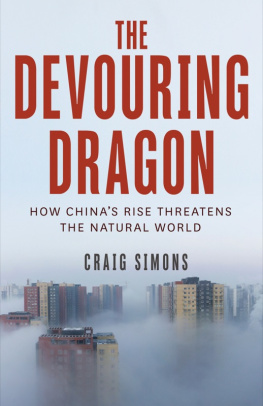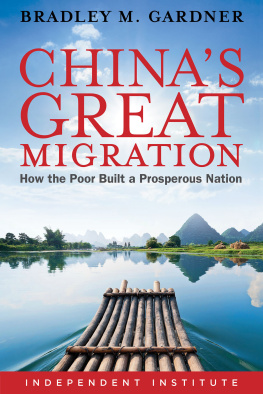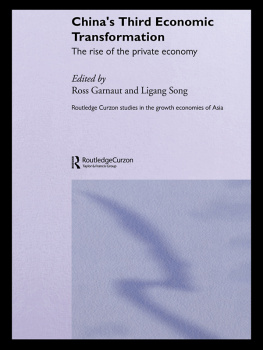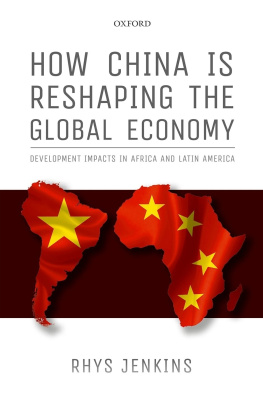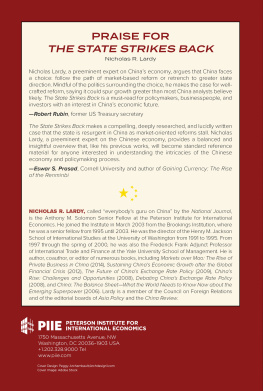
Scribe Publications
THE DEVOURING DRAGON
Craig Simons has reported on the environment from a dozen Asian nations for Newsweek and Cox Newspapers. He has also written for Outside , Backpacker , The New York Times , and The Wall Street Journal . A former Peace Corps China volunteer, he studied at Harvard University, the University of Pennsylvania, and as a 200910 Knight Science Journalism Fellow the Massachusetts Institute of Technology. He lives in Beijing.
Scribe Publications Pty Ltd
1820 Edward St, Brunswick, Victoria 3056, Australia
50A Kingsway Place, Sans Walk, London, EC1R 0LU, United Kingdom
Published by Scribe 2013
This edition published by arrangement with Awa Press, Wellington, New Zealand.
Copyright Craig Simons 2013
All rights reserved. Without limiting the rights under copyright reserved above, no part of this publication may be reproduced, stored in or introduced into a retrieval system, or transmitted, in any form or by any means (electronic, mechanical, photocopying, recording or otherwise) without the prior written permission of the publishers of this book.
National Library of Australia
Cataloguing-in-Publication data
Simons, Craig, author.
The Devouring Dragon: how Chinas rise threatens the natural world / Craig Simons.
9781922072627 (e-book.)
1. Environmental degradationChina. 2. Environmental policyChina. 3. Environmental protectionInternational cooperation. 4. Environmental responsibilityChina. 5. NatureEffect of human beings onChina.
363.70951
scribepublications.com.au
scribepublications.co.uk
To Jen and my parents,
and to Sierra, wholike all children
will inherit our decisions
CONTENTS
PART I:
PART II:
PART III:
PART IV:
AUTHORS NOTE
Anyone who writes about China faces the challenge of how quickly it changes: Chinas economy is growing by almost 10 percent each year and, with that growth, everything gets bigger. Th is book includes various numbers that describe Chinas rise and will soon be overtaken. But that will not make them less meaningful: they will remain signposts of trends that anyone who visits the country can feel in his bones, shi ft s so profound that they are changing the physical planet. Th ey also help us grasp Chinas scale: one- fift h of humanity, one-quarter of global greenhouse gas emissions, almost half of all the coal burned on earth. We should not be distracted by the constant search for new numbers. Without a major change in Chinasand the worldsdirection, they wont provide new answers. Th ey will only get bigger.
I took the major reporting trips for this book between January 2009 and March 2012, but I have lived and worked in Asia for over a decade and make occasional reference to earlier reporting.


PROLOGUE
Modern humanity was born, so to speak, about ten thousand years ago with the invention of agriculture and the villages and political hierarchies that soon followed. Up to that point our species had perfected hunter technology enough to wipe out a large part of Earths largest mammals and birdsthe megafaunabut it le ft most of the vegetated land surface and all of the oceans intact. Th e economic history that followed can be summarized very succinctly as follows: people used every means they could devise to convert the resources of Earth into wealth.
EDWARD O . WILSON , FOREWORD TO C OMMON W EALTH: E CONOMICS FOR A C ROWDED P LANET BY J EFFREY S ACHS
O n a warm spring a ft ernoon I le ft the Trails End Motel in Trinidad, Colorado, to search for signs of something I had come to think of as China speedthe countless ways that Chinas rapid growth has raised our global metabolism, the ways its enormous appetite is reshaping the physical world. At fi rst glance, Trinidad seemed like an odd place to look for ties to China. Sitting twenty miles north of New Mexico on a dry plain just east of the Rocky Mountains, it appeared insulated from global trends. Each morning locals gathered at the Savoy Caf, a small restaurant that seemed frozen in the 1950s: Marilyn Monroe posters and pressed-metal Coca-Cola signs hung on the walls, Elvis crooned from a small radio, discussions tended toward cattle prices, weather, and high school sports. In the a ft ernoon the students of Trinidad High Schoolhome of the Mighty Minerspulled their pickup trucks and rigged-out sports cars into the parking lots of fast-food restaurants. Older residents sometimes bragged that the towns courthouse was fl oored with marble cut from a quarry that supplied the Lincoln Memorial.
But I knew what I was looking for. Several months earlier, halfway around the world in Beijing, I had come across a short newspaper story about a coal mine that had quietly reopened more than a decade a ft er being mothballed. Th e mine was called New Elk and its owners planned to send much of its coal south to Texas and then by ship to Asia. According to a local paper, at least some of it was bound for China.
I suspected that China was more than a peripheral part of the story. In 2009, China had burned 3.5 billion tons of coal, almost half the worlds total. But it was Chinas potential demand that was creating a global mining renaissance. In 1976, when Mao Zedong, the fi rst leader of Communist China, died, the country had used only 550 million tons of coal each year, one-sixth of todays total. By 1997, its demand had exceeded that of the United States, but it still used what now looks like a quaint number: 1.4 billion tons. Th enin the thirteen years from 1997 to 2009China added over 2 billion tons of annual coal demand, the equivalent of two new nations as voracious as the United States, whichuntil China surpassed ithad been the worlds biggest coal consumer. And experts predicted that Chinas growing energy appetite wouldnt peak for many years.
Th e mine seemed like a perfect example of how Chinas rapid growthgrowth that since 1992 had multiplied the size of its economy sixfoldhas raised the worlds metabolism in unexpected ways. But fi ve weeks of emails to the companys headquarters had gone unanswered. When I fi nally reached its CEO by tracking down his number and cold-calling, he said the mine was too busy for even a brief visit.
I suspected the reason was more complicated. Chinas rising fortunesalmost all of it powered by fossil fuelshad pushed it past the United States as the worlds top emitter of greenhouse gases in 2006. A group of environmental organisations had recently protested new coal ports planned along the West Coast partly because they viewed exporting U.S. coal to China as undermining decades of work to slow global warming. Together with other groups, the Sierra Club had petitioned Colorados Bureau of Land Management to delay reopening the New Elk mine. Among their chief arguments was that coal from the mine could add millions of tons of carbon dioxidethe chief gas responsible for global warmingto the atmosphere over its life.
So, even without permission, I had decided to go.
I drove west from the Trails End Motela reference to Trinidads place at the end of the Santa Fe Traildown Main Street, itself a reminder of the fi ckle hand of fortune. Trinidad is one of Americas early success stories. Early settlers found thick coal seams in nearby hills and wealthy East Coast families invested in iron and steel mills. Th e city grew rich enough to build Colorados fi rst public schools and hospitals.
Next page
